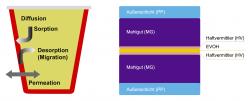Technical Report 2017-07-05
Content shown in the technical articles are the sole opinion and views of the authors or companies, which are not necessarily congruent to opinion and views of the editors.
|
Precision in seven layers Rüdiger Kissinger, motan-colortronic gmbh Worldwide, up to 2.5 billion cups of coffee are drunk every day. Much of this is prepared from coffee powder capsule portions in coffee machines. Due to the necessary oxygen barrier to prevent ageing of the coffee due to oxidation, these capsule portions consist of either aluminium or a plastic composite foil with an integrated oxygen barrier. Since 2015, the latter have been produced by the “Greiner Packaging” in Kremsmünster, Austria (Fig.1). For this purpose, a sustainable production concept was developed together with the peripheral equipment manufacturer motan and the Austrian agent Luger. With this concept, the punching waste left over after punching out the deep-drawn capsule bodies is completely fed back into the 7 layer extrusion line in accordance with all quality limits.  Abb.1: Kapseln aus einer 7-Schicht-Verbundfolie sind die moderne Art Kaffee portioniert zu lagern. Die Folie vereint Barriereeigenschaften und Recyclingfähigkeit (Foto: Greiner Packaging) 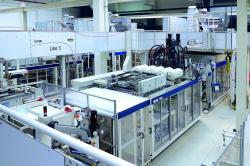 Abb.2: Die aus der Extrusionsanlage kommende 7-Schicht-Barrierefolie läuft direkt in eine Multikavitäten-Tiefzieh- und Stanzanlage. Das zurückbleibende Stanzgitter und allfällig anfallende Schlechtteile werden direkt anschließend einer Schneidmühle zugeleitet (im Hintergrund am Maschinenende) und von dort wieder in die Produktion zurückgeführt. (Foto: Autor) As mentioned at the beginning, the portion containers consist either of aluminium or plastic, both made of deep-drawn foils. However, without evaluating which is the better packaging solution, there is a significant difference between the two alternatives. Whereas an aluminium foil is a good barrier against almost all external influences, there are only very few plastics which are gas tight and aroma tight. EVOH, an ethylene vinyl alcohol copolymer, offers the best barrier properties against both oxygen and steam. It is just as water tight as an LDPE layer which is 10,000 times as thick. As it is comparatively expensive, it is used centrally as a thin barrier layer within a compound foil together with other plastics. At Greiner Packaging in Kremsmünster, Upper Austria, a 7 layer compound foil is used top produce coffee capsules. (See fact box “Multi layer foil for coffee capsules”)  Abb.3: Zur Herstellung der 7-Schicht-Barrierefolie wird ein 5-Aggregate-Extruder eingesetzt. Der zentrale Extruder ist für 70 Prozent der Folie in Form des Recyclinganteils verantwortlich. Flankiert wird er von den Extrudern für die Barriereschicht und die Haftvermittler-Schichten. Auf einer darüber angeordneten Produktionsebene befinden sich die Extruder für die PP-Deckschichten, die über vertikale Schmelzeleitungen (im Hintergrund zu sehen) an den Feed-Block angebunden sind. (Foto: Autor) As the cups of the coffee capsules are produced from the compound foil by deep drawing and punching, more than 50 per cent of the film remains as a punched frame. As this quantity of waste could not have been disposed of logistically or economically due to the projected mass production, Greiner Packaging developed a concept for complete recycling of the punching waste during ongoing production together with the long term system partners, the German motan group, a manufacturer of peripheral systems, and Luger GmbH from Austria, as motan project planners and plant fitters and the extrusion technology supplier. For this purpose, the multi layer foil to be produced must be adapted in such a way that up to 60 per cent of it can consist of the regrind of the original foil. The punched frame and waste parts are ejected directly from the deep-drawing machine and fed into a mill (Fig. 2). 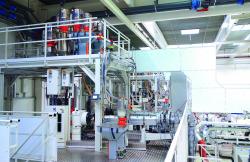 Abb.4: Die 7-Schicht-Folienanlage ist in drei Funktionsebenen übereinander aufgebaut. Auf der untersten Ebene (hier nicht sichtbar) befinden sich drei Extruder (siehe Abb.3), auf Ebene zwei befinden sich die zwei Extruder für die Deckschichten, auf der obersten Ebene die Dosiergeräte zur Versorgung der darunter befindlichen Extruder. (Foto: Autor)  Abb.5: Zentrale Mischstation zur Versorgung des „Mahlgut-Extruders“. In ihr treffen vier Materialkomponenten (Mahlgut aus dem Silo oder aus dem Big-Bag, Stabilisator für den Haftvermittler und PP-Neumaterial) zusammen, die aus den gravimetrischen Dosiergeräten in der dritten Ebene zudosiert werden. (Foto: Autor) Dosing precision lies in the detail As mentioned above, most of the material throughput is from the regrind layers, which are supplied via gravimetric dosing units and a downstream mixing system due to possible fluctuations in the bulk density. Comment by Helmut Reckziegel, Head of Business Unit Capsules: “In this regard it is worth mentioning that the regrind fed back into the multi layer foil as filler material consists of the 7 layer foil and is therefore composed of the five different viscosity materials which this contains. It was our joint objective to achieve stable mixing and flow properties for this 5 material mixture. An unstable material composition, whether due to fluctuating bulk density or a change in material proportions, leads to reductions in quality of the extrudate, in particular when seven layers have to harmonise with each other. As we wanted to install a control option for this, we provided for the addition of virgin PP material to the regrind. Therefore, the continual enrichment of the concentrations of the percentage of EVOH and of the adhesion promoter in the total foil, triggered by the return of the stamping grid, can be stabilised at 14 and 12 per cent respectively and consequently the melt flow index.” (Fig. 6) 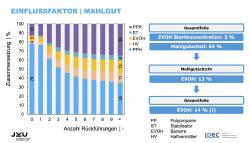 Abb.6: Einflussfaktoren auf die Zusammensetzung des im Kreislauf rückgeführten Mahlgutes. (Grafik: Greiner Packaging) All other material percentages are added volumetrically as virgin material in constant quality. The throughput quantities for the barrier material and the adhesion promoter are a maximum of 60 kg/hr. The throughput of PP layers, which are additionally mixed with a white or brown colour master batch, is somewhat more, at approx. 110 kg/hr (see Fig.1). 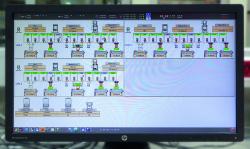 Abb.7: Sämtliche Funktionen und Einstelldaten der komplexen Förder- und Dosieranlage werden mittels CONTROLnet, einem integrierten Steuerungskonzept zur Bedienung, Überwachung und Verwaltung aller Schritte des Rohmaterialhandlings angesteuert und sind über LINKnet 2.0 an das motan-Leitrechnersystem angebunden. (Foto: Autor) All machine components are activated and operated via the remote controlled electronic modules specifically developed by motan for this purpose. These are GRAVInet for gravimetric dosing units and VOLUnet for volumetric dosing units. They are connected to a ControlNet of the central machine control via Ethernet or TCP/IP. This can be extended up to LINKnet, a comprehensive plant management system (Fig.7). It is thus possible with Linknet 2.0 to collect and log the process sequences and application data and to operate all connected controls up to device level. All motan controls with communication capability can be connected. Batch tracking is therefore continuously possible. Success due to many years of proven partnership 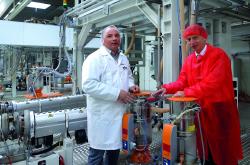 Abb.8: Helmut Reckziegel, Leiter der Business Unit Capsules innerhalb der Greiner Packaging und Horst Bar, der verantwortliche Projektleiter bei der Luger GesmbH blicken auf eine mehr als 40-jährige Zusammenarbeit mit motan zurück. (Foto: Autor) Info box: Multi layer foil coffee portion capsules What requirements? Coffee portion capsules made of foils must form a barrier against the ingress of steam, atmospheric oxygen and other unwanted substances as well as against the effects of UV radiation. The barrier must also protect against the escape of constituents such as aromas and moisture. At the same time, the foil cups can also provide protection against defined mechanical stresses during transport and storage. Which foil structure? A 7 layer compound foil is used for the coffee capsules. Its central layer consists of EVOH (ethylene vinyl alcohol co polymer). It forms the oxygen barrier and is embedded on both sides via adhesion promoter layers of recycling material (punching waste). Coloured polypropylene layers (homo polymer and co polymer) are additionally applied as cover layers. motan gmbh Otto-Hahn-Straße 14 Phone: +49 (0) 6175 792 167 Internet: www.motan.com |
 back to the list back to the list |  back to top back to top |

